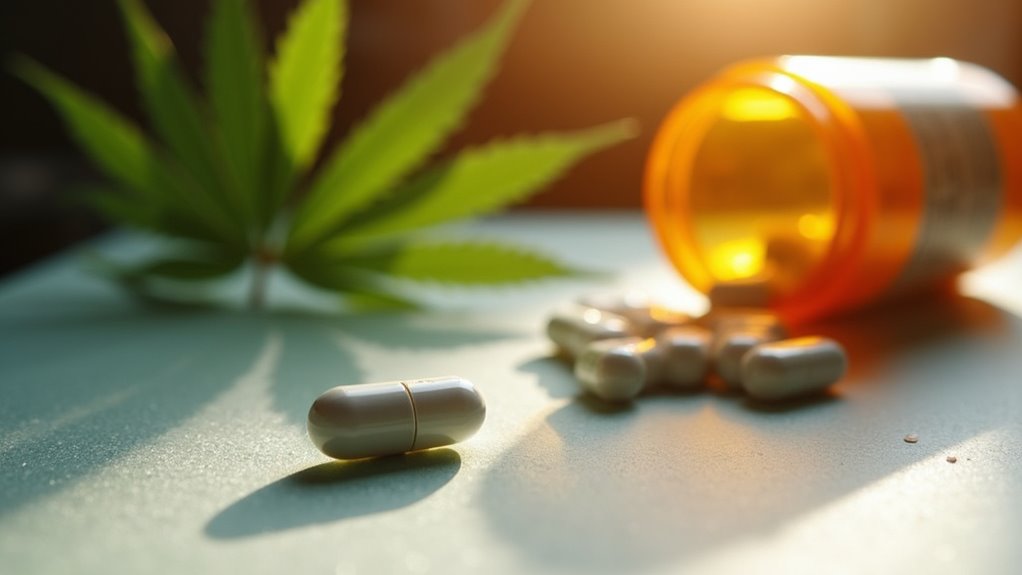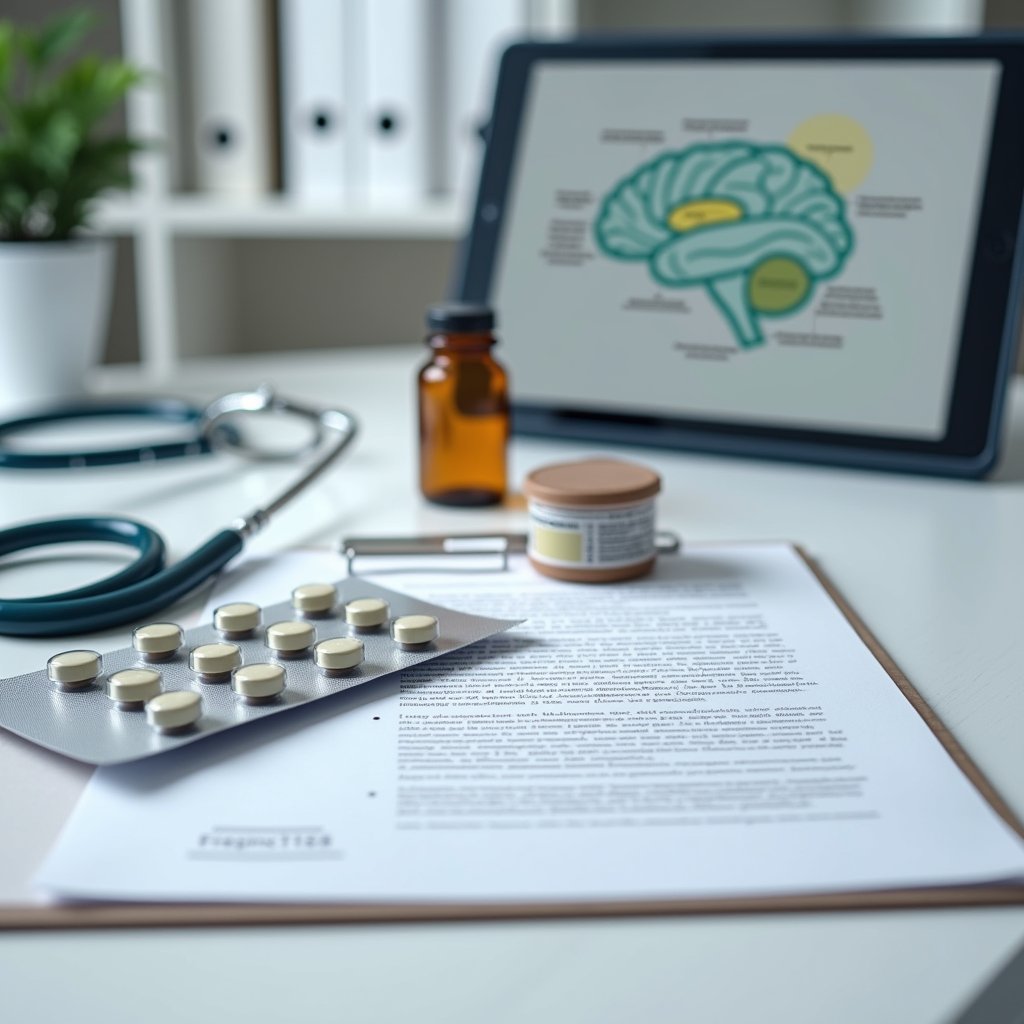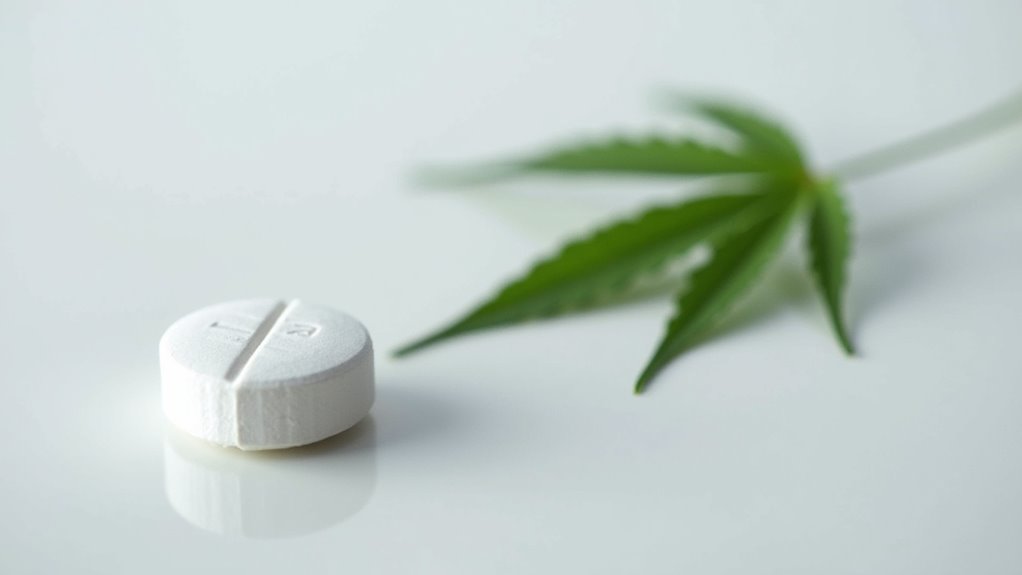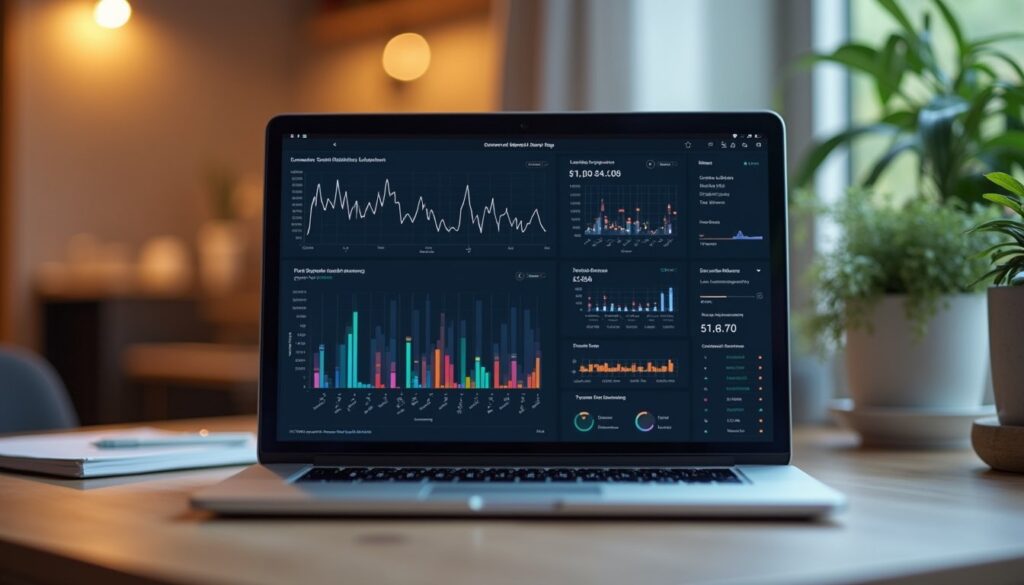Medical research has identified eight key medications to help you overcome cannabis addiction. You’ll find Gabapentin effective for withdrawal symptoms, while Naltrexone reduces dopamine-driven cravings. Varenicline disrupts reward pathways, and AEFO117 blocks THC’s psychoactive effects. Synthetic cannabinoids like Dronabinol and Nabilone, along with Nabiximols and antidepressants, round out the treatment options. Understanding each medication’s unique mechanism and success rates can guide your path to recovery.
Gabapentin: The GABA Modulator for Cannabis Withdrawal

Gabapentin, a GABA-modulating medication, shows promising efficacy in treating cannabis use disorder (CUD) through its unique mechanism of action. The medication blocks α₂δ subunits of voltage-gated calcium channels while targeting brain stress pathways activated during withdrawal. Clinical studies demonstrate that gabapentin helps restore normal functioning in emotional and motivational brain systems.
The medication’s real-world efficacy is supported by clinical trials showing twice the abstinence periods compared to placebo at 1200 mg/day. It’s particularly effective in addressing withdrawal symptoms like anxiety and insomnia while improving attention and impulse control. The medication’s off-label safety profile is well-established, with minimal risk of addiction and rare severe side effects. Initial studies revealed that patients with chronic daily use averaging 11.6 years demonstrated significant improvements with gabapentin treatment. Clinical data shows that all participants who completed the gabapentin trial maintained abstinence during the final four weeks.
What makes gabapentin especially valuable is its ability to expand cognitive therapy outcomes by reducing withdrawal-related cognitive deficits, offering a thorough approach to CUD treatment.
Naltrexone’s Role in Cannabis Use Disorder Treatment

How does naltrexone, an opioid receptor antagonist, fit into cannabis addiction treatment? It works by blocking mu-opioid receptors and reducing dopamine release associated with cannabis use, effectively diminishing the “high” you experience. Clinical evidence shows that doses between 12.5-50 mg daily can reduce cannabis self-administration and relapse rates.
Research indicates that up to 30% of adult cannabis users meet criteria for cannabis use disorder. You’ll find naltrexone most effective when combined with behavioral therapies in dual therapy combinations. The integration of cognitive behavioral therapy has shown particularly promising outcomes. In one study, participants were 7.6 times less likely to continue cannabis use during naltrexone treatment. While it can help create a therapeutic window for behavior change, you’ll need carefully managed tapering protocols to avoid side effects like nausea and dizziness.
Current limitations include the lack of FDA approval for cannabis use disorder and the need for consistent daily adherence. Keep in mind that discontinuation often leads to rebound cravings, highlighting the importance of sustained treatment under medical supervision.
Varenicline: From Smoking Cessation to Cannabis Recovery

While originally developed for smoking cessation, varenicline shows promising potential in treating cannabis use disorder through its unique interaction with nicotinic receptors. The medication’s receptor modulation targets both α4β2 and α7 nicotinic receptors, effectively disrupting cannabis reward pathways and reducing cravings.
Through cross-substance blocking, varenicline addresses the common overlap between tobacco and cannabis use. Clinical trials support its effectiveness, with a 6-week proof-of-concept trial meeting success criteria and a 72-participant pilot study showing improved abstinence rates compared to placebo. Common side effects like nausea and vomiting often lead to inconsistent medication compliance. When combined with counseling, you’ll find varenicline particularly promising for dual users of tobacco and cannabis. Safety profiles align with established smoking cessation protocols, though you’ll need to monitor for potential adverse effects during treatment. Current research continues to validate its role in cannabis addiction treatment.
AEFO117: Breakthrough CB1 Receptor Inhibitor
As research in cannabis addiction treatment advances, AEFO117 has emerged as a groundbreaking CB1 receptor signaling inhibitor that selectively blocks THC’s psychoactive effects without disrupting normal endocannabinoid function. Clinical trials have shown promising results, with the 1mg daily dose reducing cannabis use by 55% and daily consumption by 76% in motivated patients. Developed by Aelis Farma, a clinical-stage biopharmaceutical company, AEFO117 represents innovative progress in CB1-targeted therapeutics. With no FDA-approved drugs currently available for treating Cannabis Use Disorder, AEFO117 addresses a critical treatment gap.
AEFO117’s unique mechanism preserves essential cognitive functions like memory and mood regulation while targeting THC’s specific activation pathway. This allows for personalizing dosage strategies based on your CUD severity and motivation level. The medication’s well-documented safety profile shows minimal side effects and no withdrawal symptoms, distinguishing it from traditional CB1 antagonists. With Phase 2B trials confirming its effectiveness, particularly in moderate CUD cases, AEFO117 represents a significant advancement in cannabis addiction treatment. The Phase 2a trial demonstrated that participants experienced a 38% reduction in cannabis-related positive mood effects compared to placebo.
Dronabinol and Nabilone: Synthetic Cannabinoid Therapy
Dronabinol and nabilone operate as synthetic cannabinoids that target CB1 receptors, with nabilone demonstrating higher receptor affinity and bioavailability compared to dronabinol’s THC-mimicking action. Since both medications contain unique formulations, patients with sesame oil allergies should avoid dronabinol due to anaphylaxis risk.
Clinical trials have shown both medications can reduce cannabis withdrawal symptoms, though they’ve produced mixed results for sustained abstinence and require concurrent behavioral therapy for ideal outcomes. Research indicates that limited therapeutic potential exists for these cannabinoid receptor agonists in treating CUD effectively.
You’ll find standardized dosing protocols remain challenging, as both medications lack specific FDA approval for cannabis use disorder (CUD) and ideal therapeutic ranges haven’t been firmly established through large-scale studies.
Mechanism of Action
Synthetic cannabinoid therapy works by targeting the same receptor systems as natural cannabis through CB1 and CB2 receptor activation. This receptor selectivity allows for controlled modulation of physiological processes, similar to how anandamide modulation occurs naturally in your body. The medications primarily affect GABA and glutamate neurotransmission, influencing sedation and pain perception. The medications demonstrate weak partial agonist activity at cannabinoid receptors to help manage withdrawal symptoms. Studies have shown that these medications can help reduce sleep apnea symptoms in patients. The medications work through the endocannabinoid system to regulate various physiological and cognitive processes.
When you take these medications, they’re highly absorbed (90-95%) but undergo significant initial pass metabolism, resulting in 10-20% bioavailability. You’ll typically experience peak effects within 2-4 hours, with appetite stimulation lasting up to 24 hours. The psychoactive effects generally last 4-6 hours. While you may develop tolerance to some effects, the appetite-enhancing benefits remain stable for up to 5 months of continuous use.
Clinical Trial Results
Clinical trials examining synthetic cannabinoids have yielded mixed results for cannabis addiction treatment. While dronabinol has shown success in participant retention and withdrawal symptom mitigation, it hasn’t demonstrated significant reductions in cannabis use or improved abstinence rates. You’ll find that nabilone’s effectiveness remains limited, possibly due to inadequate dosing and small study populations.
Studies indicate that synthetic cannabinoids face several challenges, including short trial durations averaging 12 weeks and varying levels of participant motivation to quit. The evidence quality varies considerably – dronabinol showed moderate confidence in 10% of trials, while nabilone demonstrated minimal evidence at 4.3%. When examining dosing protocols, researchers haven’t fully established ideal ranges, with dronabinol doses typically ranging from 2.1-8.4 mg/day for addiction treatment.
Dosing and Administration Guidelines
When establishing synthetic cannabinoid therapy, proper dosing and administration protocols play a critical role in treatment success. You’ll need to start with low doses of 1-2 mg, typically administered orally, and gradually increase based on patient response. Drug interaction considerations require careful attention, especially with CNS depressants and alcohol.
| Monitoring Parameter | Safety Protocol |
|---|---|
| Mental Status | Assess for paranoia and confusion |
| Vital Signs | Monitor cardiac function |
| Liver Function | Regular hepatic testing |
| Side Effects | Watch for drowsiness |
| Drug Interactions | Screen for CNS depressants |
You’ll need to adjust dosing for special populations, particularly elderly patients who may be more sensitive to CNS effects. Implement regular monitoring safety protocols to track mental status, essential signs, and liver function. For patients with substance use history, screen carefully for potential cross-tolerance effects and adjust treatment accordingly.
Nabiximols: THC/CBD Combination Treatment
Nabiximols, administered as an oromucosal spray containing 2.7 mg THC and 2.5 mg CBD per dose, offers you a standardized approach to cannabis addiction treatment.
Clinical trials spanning 12 weeks with 128 participants demonstrate significant reductions in illicit cannabis use and withdrawal symptoms compared to placebo, while maintaining high treatment retention rates.
You’ll find the medication is generally well-tolerated, with typical cannabinoid side effects like dizziness and nausea reported as minimal concerns in outpatient settings.
Dosing and Administration Methods
The therapeutic administration of THC/CBD combination treatment follows a precise dosing protocol through oromucosal spray delivery, with each spray containing 2.7 mg THC and 2.5 mg CBD. You’ll receive weekly dispensing of medication canisters with sublingual bioavailability optimized through under-tongue or inner-cheek application. The maximum daily allowance is 32 sprays, divided into four doses throughout the day.
Dosage optimization strategies include a 3-day induction phase to assess your tolerance, followed by weekly adjustments based on your response to treatment. You’ll attend regular clinical monitoring sessions where healthcare providers track your progress and modify doses according to withdrawal symptoms and side effects. The structured program integrates CBT counseling sessions to support your recovery while maintaining strict oversight of medication allocation and usage.
Clinical Trial Outcomes
Clinical trials examining THC/CBD combination treatment have yielded promising results in cannabis addiction treatment. You’ll find significant reductions in cannabis use, with participants using 6.8 fewer days per month compared to placebo at week 12. Long term abstinence rates show 23% success in the treatment group versus 9% in placebo at 24 weeks.
| Outcome Measure | Treatment Group | Placebo Group |
|---|---|---|
| Days Reduced/Month | 6.8 | 0 |
| Abstinence Rate | 23% | 9% |
| Withdrawal Control | High | Low |
| Relapse Prevention | Effective | Limited |
When combined with MET/CBT, relapse prevention strategies show amplified effectiveness. The treatment demonstrates durability, maintaining benefits for at least three months post-treatment. You’ll experience reduced withdrawal symptoms, particularly irritability and cravings, while following a well-tolerated safety profile suitable for outpatient care.
Common Side Effects
Three primary categories of side effects commonly occur with THC/CBD combination treatment: central nervous system reactions, gastrointestinal disturbances, and neuropsychiatric effects. You may experience dizziness, fatigue, or headaches as your body adjusts to the medication.
While managing cannabis withdrawal symptoms, you might notice gastrointestinal issues like dry mouth, nausea, or stomach discomfort.
Watch for neuropsychiatric reactions, including mood changes, short-term memory issues, or sleep disturbances. Some patients report respiratory symptoms such as coughing or throat irritation.
If you’re predisposed to certain conditions, you’ll need careful monitoring for rare but serious reactions like psychotic episodes or liver enzyme elevation. Your healthcare provider will help you balance these potential side effects against the treatment’s benefits, adjusting your dosage as needed to optimize your recovery outcomes.
Bupropion and Mirtazapine: Antidepressant Approaches
Antidepressant medications like mirtazapine offer promising therapeutic options for managing cannabis use disorder (CUD), particularly during the withdrawal phase. Mirtazapine’s mechanism involves modulating serotonin and noradrenaline transmission, providing potential mood-boosting effects while helping mitigate sleep disruption through its sedative properties.
You’ll typically receive a dose of 15-45mg daily, usually taken at bedtime under close medical supervision. While mirtazapine hasn’t shown significant direct effects on reducing cannabis use, it’s most effective when combined with behavioral therapies like CBT and peer support programs.
The medication can help manage withdrawal symptoms, especially insomnia and anxiety, making it valuable as part of an inclusive treatment approach. You’ll need ongoing monitoring for side effects, particularly sedation and potential weight gain, throughout your treatment course.
Alternative Pharmacological Options in Cannabis Recovery
Beyond antidepressant medications, several alternative pharmacological approaches show promise in treating cannabis use disorder. You’ll find CBD and behavioral interventions working together as part of holistic recovery programs, while FAAH/MAGL inhibitors may enhance treatment adherence by modulating endocannabinoid levels. Nabiximols, containing a 1:1 ratio of THC:CBD, can help manage withdrawal symptoms during your recovery process.
Recent clinical trials have demonstrated that CB1 antagonists and AEF0117 can reduce cannabis use, though tolerability varies. You might also benefit from opioid receptor antagonists like naltrexone, which has shown effectiveness in reducing cannabis self-administration. When combined with behavioral therapies, these medications can provide an extensive treatment approach that addresses both the physical and psychological aspects of cannabis dependence.
Frequently Asked Questions
How Long Does It Typically Take to Overcome Cannabis Addiction With Medication?
Your recovery timeline from cannabis addiction varies individually, but you’ll typically experience withdrawal symptoms for 2-14 days. Full recovery can take several months to years, depending on factors like your usage history, support system, and commitment to treatment.
While medications may help manage withdrawal symptoms, they’re most effective when combined with behavioral therapy over 4+ sessions. Long-term success often requires ongoing support and relapse prevention strategies.
Can These Medications Be Covered by Insurance for Cannabis Addiction Treatment?
Your insurance coverage for cannabis addiction treatment likely includes prescription drug coverage under federal regulations. Thanks to the ACA mandates and parity laws, most insurers must cover addiction treatment costs likewise to physical health services.
You’ll need to verify specific coverage with your provider, as plans vary. Keep in mind that you may need preauthorization, and you’ll typically face lower costs with in-network providers and outpatient services.
What Are the Success Rates of Medication-Assisted Treatment for Cannabis Addiction?
When combined with relapse prevention strategies and cognitive behavioral therapy approaches, medication-assisted treatment shows varying success rates for cannabis addiction. You’ll find that success rates typically range from 20-30% for sustained abstinence at 6-month follow-ups.
However, you’ll achieve better outcomes when you commit to long-term treatment plans (3+ weeks) and participate in extensive programs that include both medications and behavioral therapies, potentially increasing success rates to 40-50%.
Are There Any Natural Alternatives to These Medications for Cannabis Addiction?
You can investigate several natural alternatives to support your cannabis addiction recovery. Mindfulness practices like meditation and yoga have shown promising results in reducing cravings and managing withdrawal symptoms.
While herbal supplements like valerian root and chamomile may help with sleep and anxiety, they should be used under professional guidance. Regular exercise, proper nutrition, and stress-reduction techniques like deep breathing can also strengthen your recovery path and promote general well-being.
Can These Medications Be Used While Gradually Reducing Cannabis Consumption?
Yes, you can use these medications during gradual dose reduction of cannabis, but only under close medical supervision. When tapering cannabis consumption, medications like gabapentin or naltrexone may help manage withdrawal symptoms and cravings.
Your doctor will create a personalized tapering schedule and monitor your progress. It’s essential that you don’t attempt to combine these medications with cannabis on your own, as they require careful dosing and professional oversight for safety and effectiveness.





